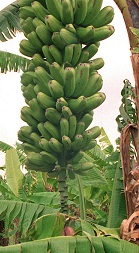
There are hundreds of varieties of Bananas, Musa spp, available for the Florida home gardener. The one we are most familiar with from childhood is the typical grocery store variety, ‘Cavendish‘. However, this was not the first commercial banana variety in the United States.
Florida is technically part of the sub-tropics. Though bananas are a tropical plant, we have lots of choices in which type of banana to plant in our state. And the University of Florida’s Tropical Research and Education Center (TREC) is developing varieties which can withstand colder temperatures, and which are resistant to Panama disease and pests. This could possibly extend the banana’s growth range a bit farther north.
Banana plant terms
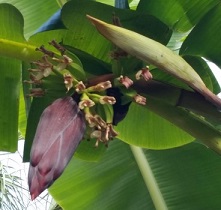
Banana ‘trees’ have a trunk called the pseudostem, which rises from a corm under ground. This corm “branches out” with underground rhizomes and fibrous roots. When these rhizomes pop up above ground and begin making leaves, they are called suckers or pups. Leaves are on a petiole which is wrapped around the pseudostem in layers forming a leaf sheath with older leaves on the outside. New growth comes from the center of the top of the plant. The ‘tree’ will send out a “Flag Leaf“, a very short leaf, from the top center of the pseudostem as the bloom stalk emerges.
On the bloom stalk, the bananas will form from the female flowers, which are usually the first to emerge, and have the ovary or small banana attached. These immature fruits seem to grow up-side-down. There will be a hand, or cluster, of bananas under each flower bract, or petal, of the tear-drop shaped blossom. Individual bananas are called fingers. Once the stalk is done making female flowers, it will keep shedding bracts of the blossom revealing imperfect male flowers under each. In most varieties, these will neither produce fruits nor pollen. There are a couple of exceptions to these last two banana rules in the “Thousand Fingers” variety and possibly others.
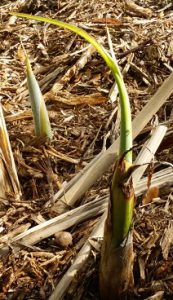
Growing tips
Once this pseudostem with the bloomstalk finishes making bananas, it will not produce any more fruit and that trunk will die off. It is best to cut down that whole trunk once you’ve harvested the fruit from it. But, another sucker will mature and produce fruit the next year.
From time of planting, it takes a banana tree roughly eighteen months to produce its first stalk of bananas. After which, the mat (entire plant including pseudostems, leaf sheaths, rhizomes, and roots) should fruit every year from a new sucker.
Banana Relatives
Banana plants are related to “Bird of Paradise” plants, gingers, Heliconia, and Canna lilies. These all grow from a spreading, underground rhizome. If you’ve ever dug up ginger or Canna lilies, you will be familiar with the corm and rhizomatous root growth. Plantains are hybrid bananas that are thicker skinned, higher in starch, not very sweet and always cooked before eating.
Origins
Bananas are originally from Southeast Asia and are thought to be some of the first cultivated fruit ‘trees’ to be intentionally spread throughout the tropical world. The Banana is really a tropical plant. It does not like frost.
Bananas in the Florida Garden
Bananas are tolerant of a wide soil pH range and there are Bananas for EVERY size garden. Some ornamental varieties can be grown in pots as a house plant. There are banana varieties which grow no bigger than 2 feet and some which are over 30 feet tall. But not all are edible.
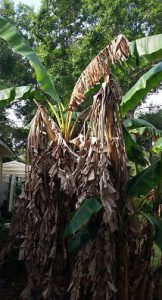
During our Florida winters we can get some cold weather, the banana’s #1 enemy aside from Panama disease. Chill damage may occur in temps below 60 degrees and may be irreversible below 32 degrees. New growth usually emerges from the underground rhizome when warmer temperatures return. I like to leave the dried banana leaves on the pseudostem from November till end of March for some protection from the cold. If a severe freeze is imminent, I will construct a simple wire mesh cylinder around the planting and pile mulch (oak leaves) up as high as I can around the pseudostem to protect the trunks from frost. After the cold event, remove the cage and spread the leaves around the banana trunks. This keeps the mulch nearby in case of another cold event.
Banana Uses
Bananas are a very useful plant. The old leaves can be used for fiber to make floor mats, baskets, hut roofing, cordage, woven “jewelry”, paper and even cloth. Fresh leaves can be used as an emergency rain hat, as ‘paper plates’, or for grilling food in a leaf-parcel. I like to cook Salmon in a Banana leaf over the gas grill for special holidays. It imparts an interesting flavor you don’t get when cooking fish in foil and the wrapped leaf keeps the fish moist.
Edible parts are more than just the fruits. The blossom is made into a salad in Asia and can be cooked as a vegetable, as can the corms (if you have an abundance). Plantains and unripened bananas can be cooked like potatoes – boiled, poached, stewed, or smashed and fried into a common Central American food called “tostones” which tastes very much like french fries. In the Caribbean, they make a breakfast ‘porridge’ out of unripe bananas by grinding them, skins and all, in a blender. You then add water and boil the pulp. Add spices if desired and some jam for sweetener. This porridge is said to be high in iron.
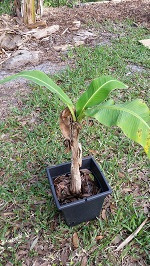
Easy Banana Varieties for South Florida
- “Apple” or “Manzana”, is a small, sweet, slightly apple-flavored banana. It must be soft ripe or it is astringent. It is regularly available at one of our local Florida grocery stores.
- “Orinoco” is the banana settlers most likely encountered, also referred to as the “Horse Banana”, it is a cold tolerant variety. Not too sweet, can be used as a plantain when under-ripe.
- “Rajapuri” is a premium, tasty variety. Not wind tolerant. It is slow to sucker.
- “Ice Cream“, or “Blue Java”, is another small, very tasty variety. It ripens while still green. This “tree” is a large one, readily suckering.
- “Goldfinger“, or “FHIA-01”, is a newly developed hybrid with finger-small fruit. The flesh is sweet and golden yellow.
Collecting Bananas
Some interesting varieties if you’d like to become a banana collector are:
- ‘African Rhino Horn‘- very long, curving plantain type
- ‘Thousand Fingers‘- very large rack with hundreds of fruits.
- ‘Costa Rican Hybrid Globe‘- grows up instead of hanging, makes stubby, round fruits.
- ‘Double Banana‘- makes two or more stalks at a time
- ‘Dwarf Red‘- fruit skins are a deep burgundy color
- ‘Gros Michel‘- the original commercial banana, now only tissue culture plants remain.
- ‘Praying Hands‘, dense clusters, fingers seem pushed together like hands praying
- ‘Rose‘- has a bright red pseudostem and edible fruit
- ‘Pink‘- makes bright pink ‘bananas’ which are loaded with seeds and hardly edible.
Learn More
The University of Florida has a wonderful EDIS publication #HS10: “Banana Growing in the Florida Home Landscape” which is FULL of research-based information and charts of varieties and their growth range, care, propagation, harvesting, when to fertilize and planting how-to.
The book, Bananas You Can Grow, by James W. Waddick & Glenn M Stokes (Stokes Tropicals Publishing Co., ISBN 0-9678540-1-6) has banana history, fun trivia, recipes, and a gallery section of varieties with height, uses, and photos.
The Complete Book of Bananas, by W. O. Lessard has very good care instructions and scouting directions for diseases from a Banana farmer with many decades of experience with over 50 varieties.
Banana: The Fate of the Fruit That Changed the World, by Dan Koeppel is a fascinating history of banana fruit imports and how they changed the politics of the Americas starting as early as the 1870’s.
 4
4
